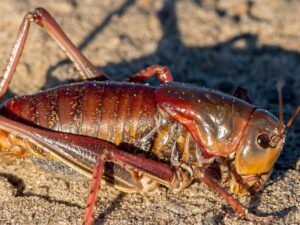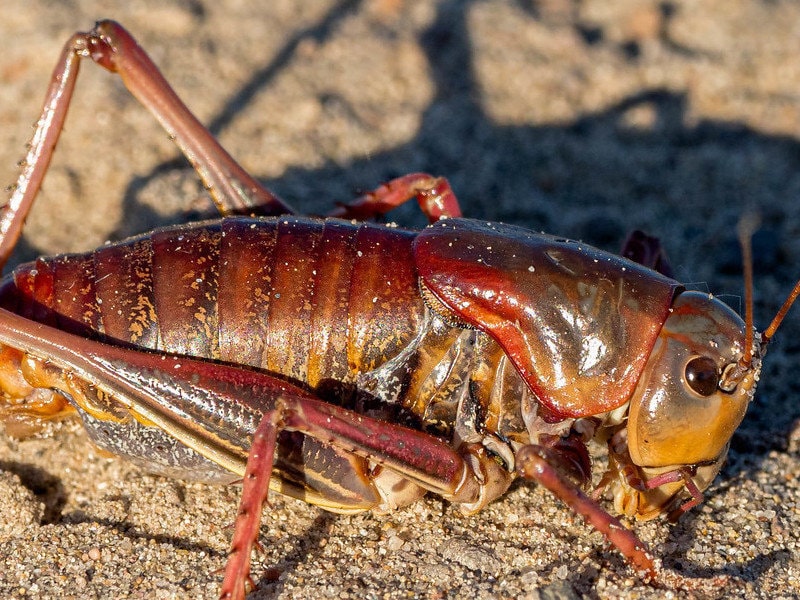Mormon Crickets

Table of Contents
Mormon crickets, despite their name, are not true crickets, but a type of large insect that belongs to the family of katydids. Famous for their massive migrations, these insects have a fascinating biology and a complex relationship with both the environment and human activities. Let’s dive into the world of Mormon crickets and discover what makes them so unique.
Key takeaway:
- Mormon crickets, though named as such, are not true crickets but rather belong to the katydid family. Despite this misnomer, they are large insects known for their remarkable massive migrations.
- Their habitat is primarily in the western United States and parts of Canada, where they thrive in arid landscapes like deserts, grasslands, and sagebrush.
- Mormon crickets are omnivorous, consuming various plants, other insects, and even members of their own species.
- Their life cycle involves complex mating rituals, egg-laying in soil during spring, and several developmental stages from hatching to adulthood.
- While fascinating in their biology, Mormon crickets can also be a significant threat to agriculture due to their voracious appetite. Implementing preventative measures like barrier methods, landscape maintenance, and eco-friendly control methods can help manage their impact on crops and natural ecosystems.
Identifying Mormon Crickets
Mormon crickets are large, often over 2 inches in length, with a robust body. They exhibit variations in color, including shades of black, brown, and green. Despite having wings, most are flightless.
Habitat
These insects are native to the western United States and parts of Canada. They thrive in arid landscapes like deserts, grasslands, and sagebrush.
Diet
Mormon crickets are omnivorous and feed on a variety of plants, other insects, and even their kind.
Life Cycle of Mormon crickets

Mating
Mating rituals among Mormon crickets include complex behaviors, with males offering nutritious “nuptial gifts” to attract females.
Egg Laying
Females lay their eggs in the soil, where they remain until the next spring.
Growth and Development
After hatching, the nymphs go through several developmental stages, shedding their exoskeletons before reaching adulthood.
Mormon Crickets and Agriculture
Damage to Crops
Mormon crickets can cause significant damage to crops, especially during their migration phase. Their voracious appetite for plants can lead to extensive losses.
Preventative Measures
Barrier Methods
Using barriers like fences or trenches can prevent Mormon crickets from entering your property. These physical obstructions can deter or redirect their movement.
Landscape Maintenance
Regular maintenance of your yard, like removing debris and managing vegetation, can make the area less appealing to Mormon crickets, thus preventing an infestation.
Control Methods
Chemical Control
Insecticides specifically designed to target Mormon crickets can be effective. Always follow the manufacturer’s instructions and consult professionals if needed.
Biological Control
Introducing natural predators like birds or utilizing fungal pathogens that target insects can be an eco-friendly approach to controlling the population.
Mechanical and Manual Control
Simple methods like handpicking or using vacuum devices can be useful for small-scale infestations. Mechanical traps can also be employe
Conclusion
Mormon crickets are a remarkable species, with intriguing behaviors and significant impact on both natural ecosystems and human agriculture. Their study offers insights into insect biology, ecology, and the delicate balance between humans and nature.
FAQ
Mormon crickets are a type of large insect belonging to the katydid family, known for their mass migrations and impact on agriculture.
Though they have wings, most Mormon crickets are flightless
Control measures include using chemical insecticides, introducing natural predators, and employing barriers or traps.
The name comes from the Mormon pioneers who encountered these insects in the 19th century.
While they can cause significant damage to crops, Mormon crickets are generally not harmful to humans.

